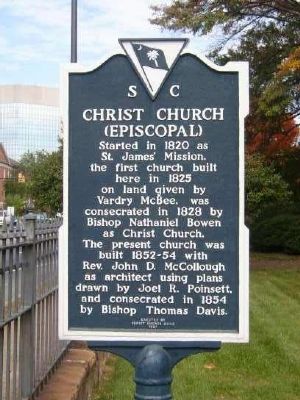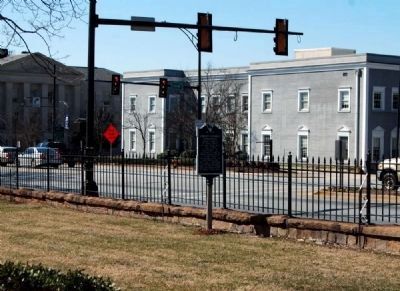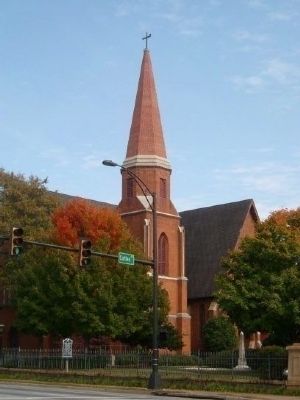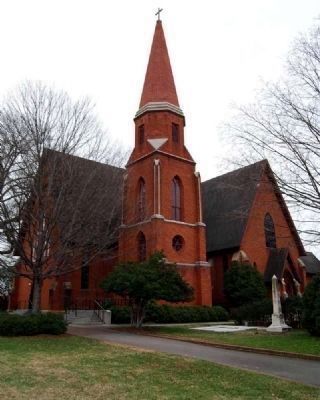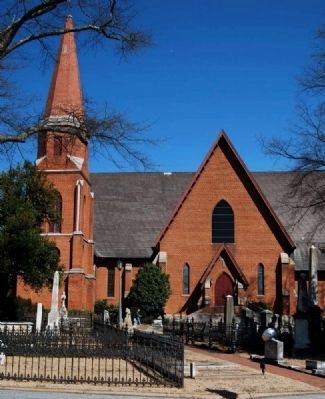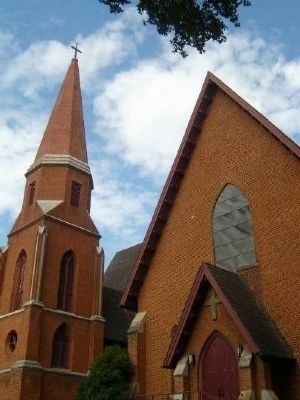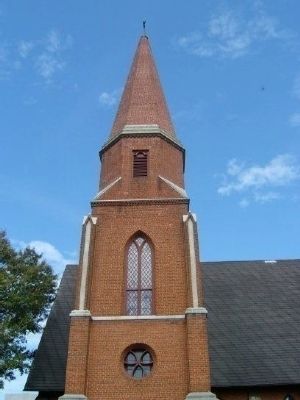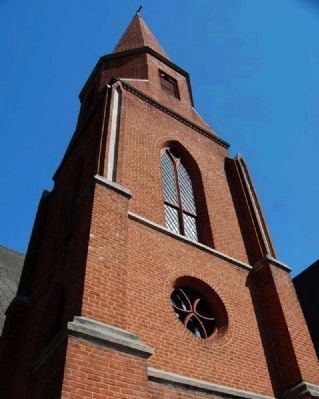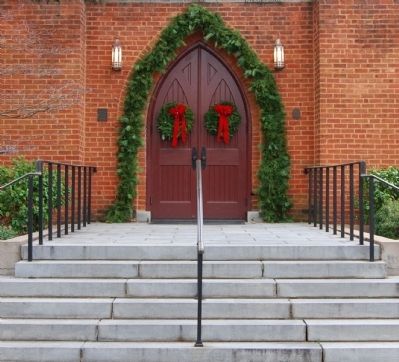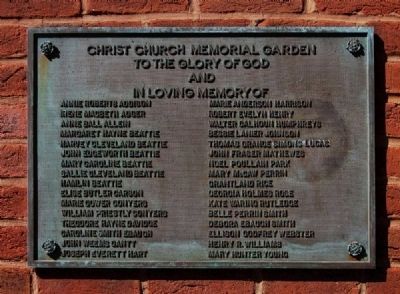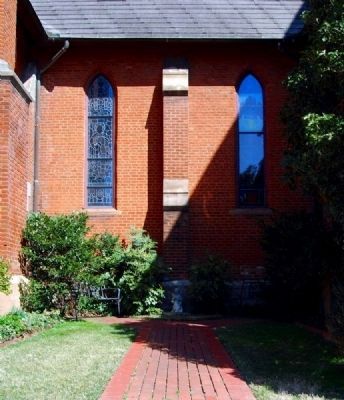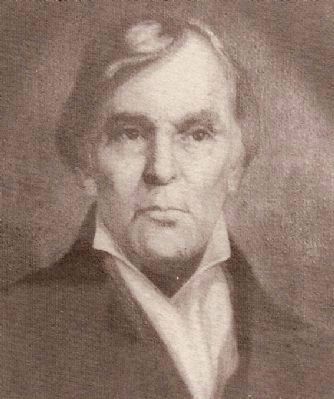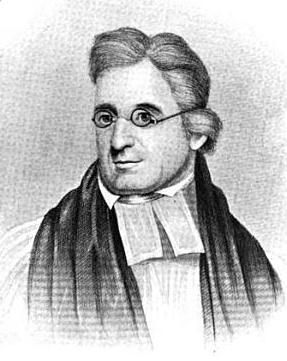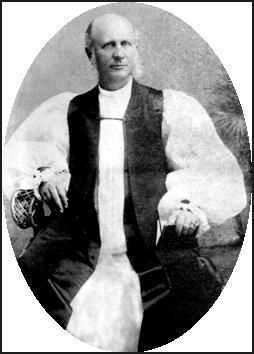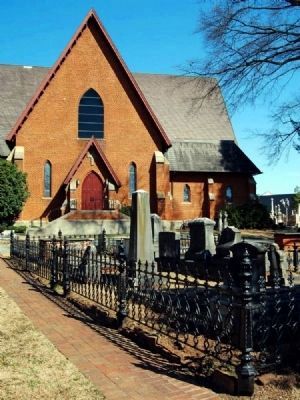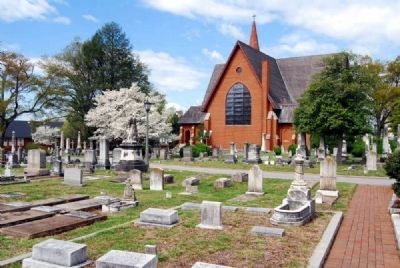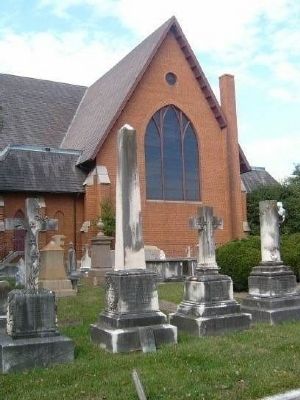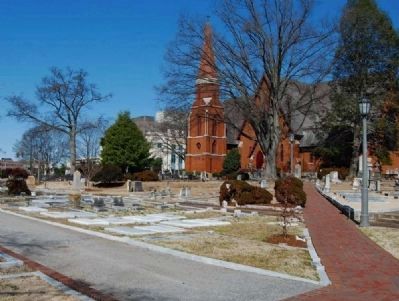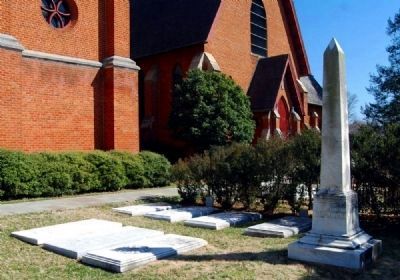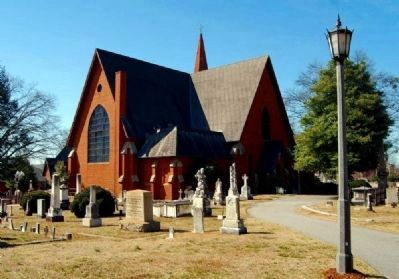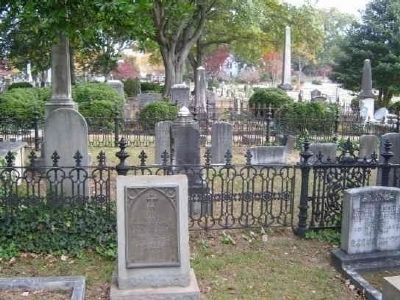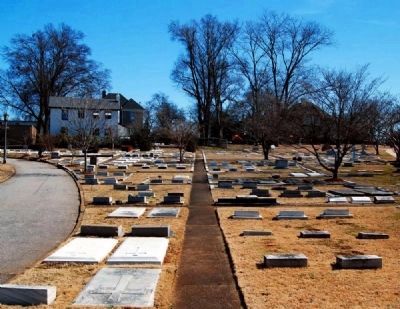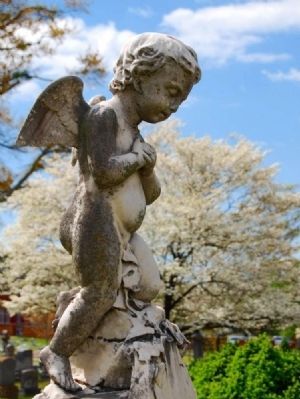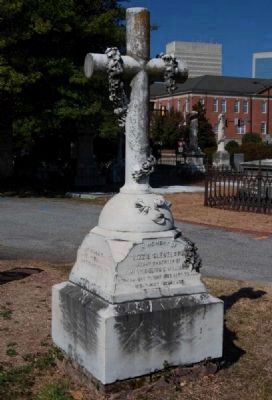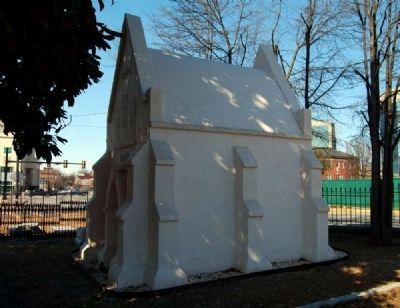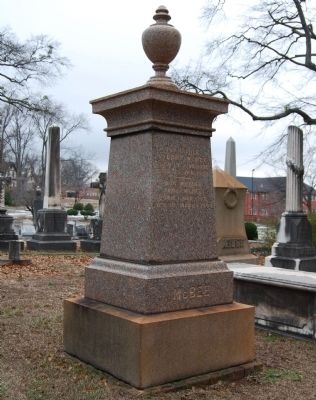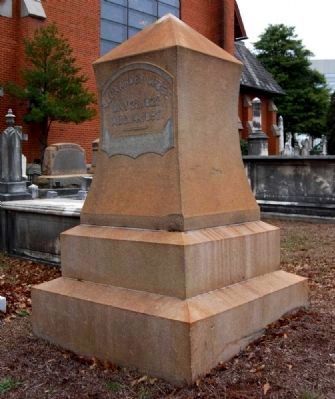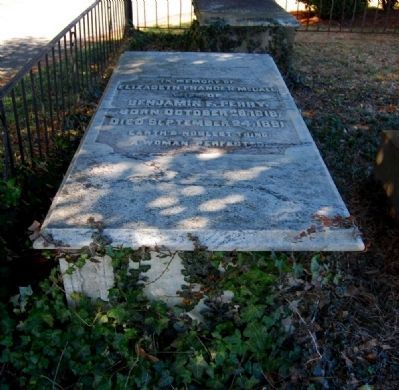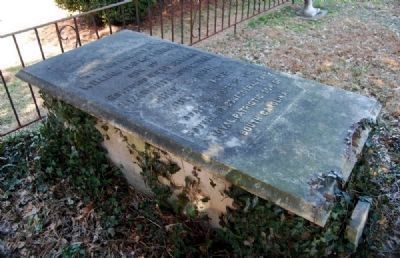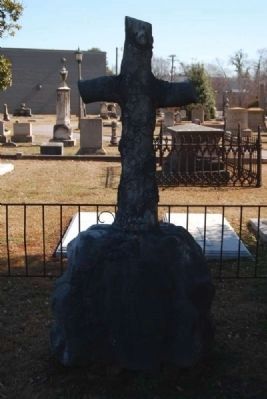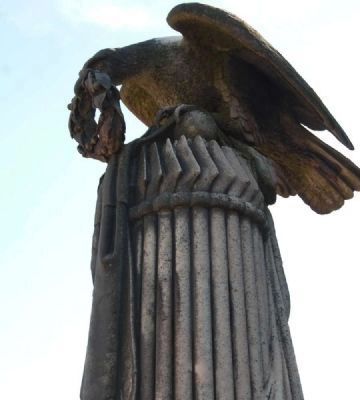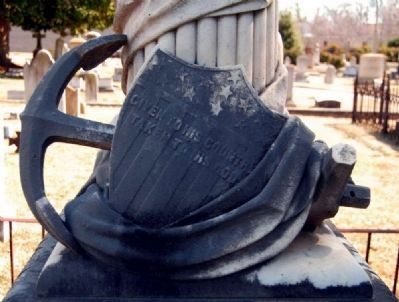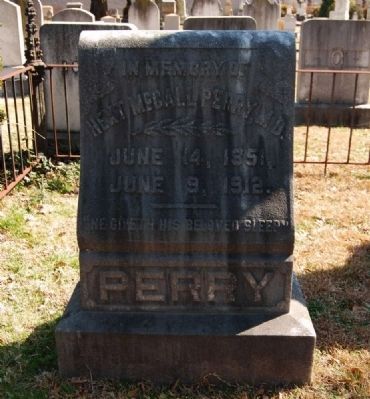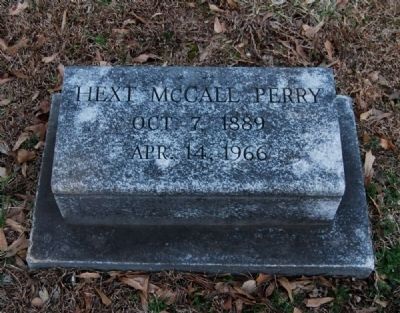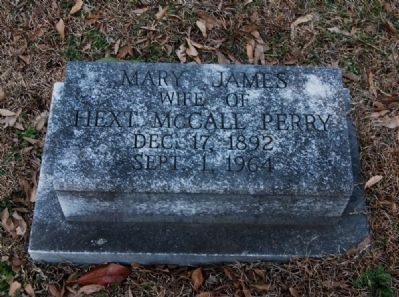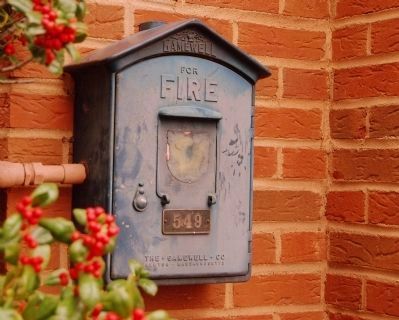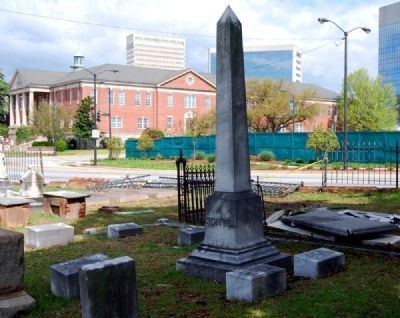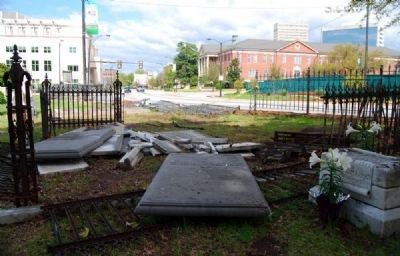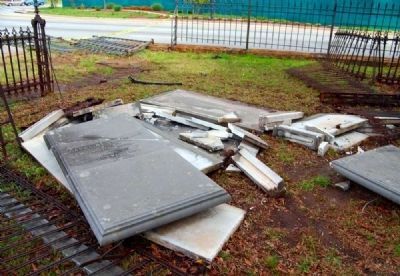Greenville in Greenville County, South Carolina — The American South (South Atlantic)
Christ Church (Episcopal)
Started in 1820 as St. James' Mission, the first church built here in 1825 on land given by Vardry McBee, was consecrated in 1828 by Bishop Nathaniel Bowen as Christ Church. The present church was built 1852-54 with Rev. John D. McCollough as architect using plans drawn by Joel R. Poinsett, and consecrated in 1854 by Bishop Thomas Davis.
Erected 1967 by Christ Church Guild. (Marker Number 23-10.)
Topics. This historical marker is listed in these topic lists: Churches & Religion • Notable Buildings. A significant historical year for this entry is 1820.
Location. 34° 51.06′ N, 82° 23.686′ W. Marker is in Greenville, South Carolina, in Greenville County. Marker is on North Church Street (U.S. 29) south of East North Street (South Carolina Highway 183), on the right when traveling north. Marker is located on the west lawn of the churchyard. Touch for map. Marker is at or near this postal address: 10 North Church Street, Greenville, SC 29601, Greenville SC 29601, United States of America. Touch for directions.
Other nearby markers. At least 10 other markers are within walking distance of this marker. Here Lieth the Body of Sarah M. Crittenden (within shouting distance of this marker); In 1825 (about 300 feet away, measured in a direct line); Church Street (about 400 feet away); Frank Selvy (about 800 feet away); Little Texas (approx. 0.2 miles away); "Shoeless" Joe Jackson (approx. 0.2 miles away); Greenville Memorial Auditorium (approx. 0.2 miles away); Clayton "Peg Leg" Bates (approx. 0.2 miles away); Frank Howard (approx. 0.2 miles away); Site of First Baptist Church / Baptist Seminary (approx. 0.2 miles away). Touch for a list and map of all markers in Greenville.
Also see . . .
1. Christ Church (Episcopal). The official website of Christ Church (Episcopal). (Submitted on April 20, 2008, by Kevin W. of Stafford, Virginia.)
2. Christ Church (Episcopal). Historically, Christ Church is Greenville’s oldest organized religious body (1820) as well as the city’s oldest church building (1852-1854). (Submitted on September 16, 2008, by Brian Scott of Anderson, South Carolina.)
3. Christ Church (Greenville, South Carolina). Christ Church (Episcopal) is an Episcopal church in Greenville, South Carolina (USA) which was consecrated in 1854. (Submitted on March 21, 2009, by Brian Scott of Anderson, South Carolina.)
4. Nathaniel Bowen. Nathaniel Bowen (June 29, 1779 – August 25, 1839), was the third bishop of South Carolina in the Episcopal
Church in the United States of America. (Submitted on January 11, 2009, by Brian Scott of Anderson, South Carolina.)
5. Joel Roberts Poinsett. Joel Roberts Poinsett (March 2, 1779 – December 12, 1851) was a physician, botanist and American statesman. (Submitted on March 21, 2009, by Brian Scott of Anderson, South Carolina.)
6. Ellison Capers. Ellison Capers (October 14, 1837 – April 22, 1908) was a school teacher, Confederate general in the American Civil War, theologian, and college administrator from South Carolina. (Submitted on July 24, 2009, by Brian Scott of Anderson, South Carolina.)
Additional commentary.
1. Christ Church (Episcopal)
The present building, for which the cornerstone was laid on May 29, 1852, replaced the original small church which was erected in 1825 on approximately the same site. The Reverend John DeWitt McCullough, D.D. is the credited architect. Consecration of the building took place September 29, 1854.
In January 1856, the new Christ Church was described in the Southern Episcopalian as “First Point Gothic, length 112 feet, five lancet windows, western end a pantaphlet ad a circle with emblem of the Holy Trinity, triplet window in chancel, glass by Wills of New York, vestry in north
transept, the tower is connected with the south porch, spire rising to 130 feet…”
Innovations have included addition of a gallery in the west end, 1875; addition of south transept and enlargement of chancel, 1830. In 1968, the fabric of the church was restored and the following additions made: extension of east sanctuary wall, addition of north transept, enlargement of balcony, construction of Galilee porch at northwest corner, excavation for undercroft beneath entire church, fireproof flooring and remodeled entrances. Increased seating capacity from 350 to 650 achieved completion of the original cruciform design after 114 years without altering the over-all plan.
Significance
Historically, Christ Church is Greenville’s oldest organized religious body (1820) as well as the city’s oldest church building (1852-54). It has traditionally been recognized as an outstanding example of Gothic architecture. Each addition has been in keeping with its style and original plan for a cruciform building. A magnificent stained glass window by Mayer of Germany is a memorial to Ellison Capers, rector of Christ Church (1866-1888), bishop of the Diocese of South Carolina (1893-1908), and Confederate brigadier general.
In the churchyard (the burying ground) surrounding the building are buried former governor of South Carolina, Benjamin Franklin Perry; several Greenville mayors; many Confederate war dead and the first Greenville man lost in World War I. Also interred here are the parents and son of the first Bishop of the Diocese of Upper South Carolina; Vardry McBee, “Father of Greenville”; and many other church and civic leaders. A South Carolina historical marker was erected here in 1967. (Source: National Register nomination form.)
— Submitted March 21, 2009, by Brian Scott of Anderson, South Carolina.
2. More About Christ Church (Episcopal)
Christ Church Episcopal Church is the oldest extant church and earliest established congregation in Greenville. It began when Reverend Rodolphus Dickerson arrived in 1820 to establish an Episcopal presence in the village through St. James Mission. Dickerson was able to attract a few natives but soon discovered that the population (and congregation) would swell in the summers when Charlestonians would make their retreat to Greenville. Services were held in the log courthouse in the center of Court Square. Five years later, Vardry McBee (even though he was still living in North Carolina) provided four acres of land on the east side of the village for the St. James congregation to build a church. This first structure was built on the same property of the current church but was located just to the south. The first small brick church measured fifty-five by thirty by eighteen feet and took many years to fully complete. A balcony for African Americans and a belfry were added in the 1830s with funds obtained through the common practice of renting church pews. St. James Mission was admitted into the Diocese in 1828 and was renamed Christ Church.
Greenville's growth and prosperity began to take off in the next decades, and so did the size of Christ Church congregation. Plans began in 1845 for the erection of a larger church to meet their needs. Initially plans were submitted by Vestryman Joel Poinsett but were later rejected for the high cost. Eventually Reverend John D. McCollough's Gothic cruciform designs (similar to designs by popular Neo-Gothic architect Richard Upjohn) were accepted and a cornerstone was laid in 1852. Bricks from the former church were used as the foundation of the new one. Two years later the new $15,000 brick building was dedicated but consisted only of the nave and a belfry. The nave is thirty-nine feet wide with short brick buttresses and a sixty-five-foot-high steep gabled roof that slopes halfway down the building's height. The sides of the nave were pierced with narrow lancet arch windows with stained glass. One of the stained-glass windows was made by Tiffany & Co. in New York City (other Tiffany windows in Greenville may be found in Bob Jones University's boardroom and at the Gassaway Mansion). The altar wall of the nave originally had three tall narrow lancet arch stained-glass windows by Wills of New York. Funds raised by ladies in the Christ Church Guild were put toward the installation in 1914 of a massive stained-glass window depicting Christ's Ascension and The Last Supper created by Mayer Studios of Munich, Germany.
The impressive belfry rises 130 feet into the air and is set asymmetrically off to the side -- a technique derived from English country models and used by Richard Upjohn in New England. The simple square-shaped base has projecting corner piers, all of which provide the foundational means to support the weight of the tower. The second tier has a decorative oculus stained-glass window and trefoil design on the south side with short lancet arch windows on the east and west ends. The third part of the tower is the tallest brick section, with soaring lancet arch windows on each side. The angled transition with inverted triangular broaches narrows to the next level, creating an octagonal shape for the remainder of the structure. Four rectangular windows provide variety for the fourth level before a brick (not tile or copper) octagonal steeple soars to its pointed apex. The transepts were added in later years (1880 and 1958) and complete the original design plan.
Christ Church (Episcopal) is the only downtown church to have a cemetery associated with it on the grounds (as directed by Vardry McBee). The first grave was established in 1835 by parishioner Sarah Crittenden. It is the final resting place for many of Greenville's leaders, including Vardry McBee, Governor Benjamin Perry, Mayor T.C. Gower, H.C. Markley and Hamlin Beattie. (Source: A Guide to Historic Greenville, South Carolina by John M. Nolan, 2008 pgs 115-117.)
— Submitted April 11, 2009, by Brian Scott of Anderson, South Carolina.
3. Nathaniel Bowen
The son of a clergyman who was a convert from the Congregationalists, Nathaniel Bowen was born in Boston, June 29, 1779.
His father removed with his family to Charleston, S.C., 1787. On the death of the elder Bowen, shortly after his arrival, the Rev. Robert Smith, subsequently the first bishop of South Carolina, took charge of the orphan boy and provided for his education. The lad was an apt scholar, and on his graduation at Charleston College, 1794, received an appointment as tutor at his alma mater, where he continued for several years.
Returning to his native city, Bowen prepared himself for holy orders, under the charge of Dr. (afterward Bishop) Parker, and was admitted to the diaconate in Trinity Church, Boston, June 3, 1800, by Bishop Bass. He was advanced to the priesthood in October 1802, at St. Paul's Church, Newburyport, by the same prelate. The day of his ordination is not known with certainty. After a brief pastorate at St. John's Church, Providence, R.I., Bowen returned, March 1802, to Charleston, where he became the assistant minister of St. Michael's Church, succeeding to the rectorship, 1804. Five years later he removed to New York and became rector of Grace Church in that city. He received his doctorate in divinity, 1814, from the University of Pennsylvania and from the College of South Carolina.
Bowen received consecration in Christ Church, Philadelphia, Oct. 8, 1818, Bishops White, Hobart, Kemp, and Croes being his consecrators. After an episcopate of upward of twenty years, Bishop Bowen died at Charleston, S.C., Aug. 25, 1839. His remains were interred in the chancel of St. Michael's Church. To unusual pulpit powers he added great executive ability and a commanding influence over men. He was an accomplished scholar, a wise theologian, and a holy man. (Source: The Episcopate in America: Sketches, Biographical and Bibliographical, of the Bishops of the American Church by William Stevens Perry (1895), pg 39.)
— Submitted February 20, 2010, by Brian Scott of Anderson, South Carolina.
4. About Vardry McBee
Vardry McBee was perhaps the most pivotal figure in the history of our city and Greenville County as a whole. thanks to his business acumen and impressive foresight for how the community could grow and prosper.
A product of the Carolina frontier, McBee was born in 1775 on the eve of the American Revolution, a conflict that would prove formative in his early years. Both his father and older brother fought with the Patriots, at King's Mountain and the Battle of Cowpens. McBee himself never fought for American independence, but instead used his considerable fortune to improve the lives of his fellow citizens, appropriating his land and fortunes to public projects.
McBee opened the first textile mill on the Reedy River, but he saw value in a diversified economy. In his private business life, that meant he owned two flour mills, a cotton factory, and wool and paper mills. Publicly, even as he approached his 80s, it led him to champion the construction of a railroad line that connected Columbia and Greenville. In 1853, this line became the first rail to serve the community, and it would eventually become a turning point in the economy of the town. (Source: G: The Magazine of Greenville, Jan/Feb 09, pg 66.)
— Submitted March 21, 2009, by Brian Scott of Anderson, South Carolina.
5. McBee's Tithe
Vardry McBee, the father of Greenville, donated land and $500 worth of limber from his mill on the Reedy River to five congregations. This act was known as McBee's Tithe. These were the first five churches in downtown Greenville (and they contribute to Greenville's nickname: the Church City). The five churches are: First Baptist, First Presbyterian, Christ Church (Episcopal), St. Mary's Catholic, and Buncombe Street United Methodist.
— Submitted March 21, 2009, by Brian Scott of Anderson, South Carolina.
6. About Joel Robert Poinsett
It's widely known that Joel Poinsett was the first ambassador to Mexico, a position he held for five years, but he also served as the first consul-general of the United States to Buenos Aries, Argentina, and Santiago, Chile. He studied medicine and law, and not surprisingly was extremely well traveled, but he also had interests in natural history, science, and politics.
While serving in the South Carolina legislature, Poinsett was appointed president of the board of public works from 1819 to 1821, a position that had him overseeing construction of the state road that traversed Saluda Mountain. This road (modern-day S.C. Secondary Road 42) ran from Charleston, through Columbia, and into North Carolina, creating a seamless connector capable of accommodating even the "heaviest load," in places of several ineffective roads already in existence. Not surprisingly, more than twenty years later, he would join Vardry McBee and others to support connecting Columbia and Greenville by rail. (Source: G: The Magazine of Greenville, Jan/Feb 09, pg 68.)
— Submitted July 23, 2009, by Brian Scott of Anderson, South Carolina.
7. More About Joel Roberts Poinsett
Poinsett, Joel Roberts, a Representative from South Carolina; born in Charleston, S.C., March 2, 1779; spent his early childhood in England; returned to America in 1788; attended private school at Greenfield Hill, Conn., and later in Wandsworth, near London, England; studied medicine at the University of Edinburgh, Scotland, and attended the military school in Woolwich, England; returned to Charleston, S.C., in 1800; studied law for a few months; traveled extensively in Europe from 1801 to 1809, returning to the United States for short intervals; sent to South America by President Madison in 1809 to investigate the prospects of the revolutionists there in their struggle for independence from Spain; returned to Charleston, S.C., in 1816; member of the state house of representatives
1816-1819; served as president of the board of public works; declined the offer of commissioner to South America by President Monroe; elected as a Republican to the Seventeenth Congress reelected as a Jackson Republican to the Eighteenth Congress, and elected as a Jacksonian to the Nineteenth Congress and served from March 4, 1821, to March 7, 1825, when he resigned to enter the diplomatic service; Minister to Mexico 1825-1829; member of the state house of representatives, 1830-1831; Secretary of War in the Cabinet of President Van Buren 1837-1841; died near what is now Statesburg, Sumter County, S.C., December 12, 1851; interment in the Church of the Holy Cross (Episcopal) Cemetery. (Source: Biographical Directory of the U.S. Congress.)
— Submitted September 20, 2009, by Brian Scott of Anderson, South Carolina.
8. The Rectorships of Thomas S. Arthur and Bishop Ellison Capers
Christ Church had undergone its own agonizing Reconstruction at the close of the Civil War, but it emerged with strong leadership. In 1866 Thomas S. Arthur had been rector of the parish for twenty years. He had led the construction of the new church building, founded the Dehon School for the Poor in 1851, and remained through the trying war years. On February 7, 1866, Arthur submitted a bitter letter of
resignation to the vestry: "This flock and this fold have been my constant care for nearly a quarter of a century Some of them, it is true, have stoned me to my present attitude I may shortly be called upon to submit to the annoyance of an Ecclesiastical Trial. If this trouble should come upon me, let me beseech you, brethren, not to withdraw your arm from around me." The vestry did not accept Arthur's resignation, but the trial came anyway.
William H. Campbell of Greenville, Arthur's brother-in-law, leveled serious charges of sexual misconduct against the rector. The parish was divided, and Bishop Thomas Davis appointed two clergy, Paul Trapier and J.S. Hanckel, to investigate the matter. In June 1866 Trapier arrived in Greenville and was joined by Hanckel. They gathered depositions, and on October 3 Arthur submitted a second letter of resignation. This time it was accepted. The bishop convened a trial court the following year with former rector of the parish, Charles Cotesworth Pinckney, as judge. Two attorneys participated in the proceedings. Armistead Burt of Abbeville represented the diocese, and former Confederate General Matthew C. Butler, himself once a member of the parish, represented the accused. Arthur was apparently acquitted on the major charges, but was found guilty on two minor counts and was suspended from parish work for five years. He continued to live
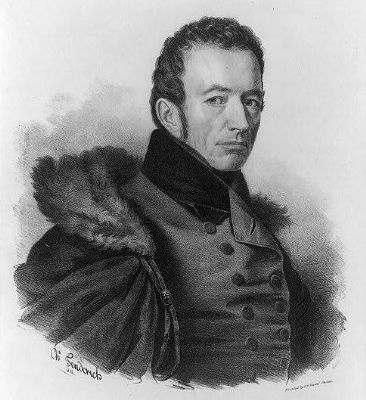
Photographed By Wikipedia
14. Joel Roberts Poinsett
(1779–1851)
(1779–1851)
S.C. House of Representatives 1816-1820
S.C. Board of Public Works 1818-1820
U.S. House of Representatives from S.C. 1821-1825
Special U.S. Envoy to Mexico 1822-1823
U.S. Ambassador to Mexico 1825-1830
S.C. House of Representatives 1830-1833
U.S. Secretary of War 1837–1841
Christ Church faced an uncertain future until the church secured the services of Ellison Capers as lay reader. Born in 1837 in Charleston, the son of Methodist Bishop William Capers, the younger Capers was a graduate of the Citadel and taught mathematics prior to joining the Confederate army. At the end of the war, after the Battle of Franklin, Tennessee, he was promoted to the rank of brigadier general. During the fighting Capers had decided to enter the ministry, and though he became South Carolina's secretary of state in 1865, he began to read the orders under the direction of Bishop Davis. He served as lay reader at Christ Church until he was ordained deacon and priest in 1867. He then resigned as secretary of state and became rector of the parish, a post which he held, with the exception of one year, until 1887. In 1893 Capers was elected bishop coadjutor of the diocese and, after the death of Bishop W.B.W. Howe, became bishop of South Carolina.
For twenty years Ellison Capers lived and served in Greenville. Early in his tenure he decided to appeal to a number of wealthy parishes in the North for financial aid. One day in New York City Capers met James Petigru Boyce, his Greenville neighbor, on the street.
When Boyce inquired about Capers's success, Capers replied that after his last sermon only one five dollar bill appeared in the collection plate. To which Boyce replied: "And I your neighbor put that in." In addition to his ministry at Christ Church, Capers taught mathematics at the Female College, at Furman University, and at the Greenville Military Academy. He actively participated in many facets of the life of the city, such as the Literary Club and the Independent Riflemen during the election of 1876. Because of his service as a general officer in the Confederate Army, he was a living reminder in the community of the Lost Cause. (Source: Greenville: The History of the City and County in the South Carolina Piedmont by Archie Vernon Huff, Jr. (1995), pgs 206-207.)
— Submitted September 20, 2009, by Brian Scott of Anderson, South Carolina.
9. Driver charged with DUI after Christ Church cemetery incident
The Greenville News
E. Richard Walton
April 5, 2009
A 22-year-old Greenville man was charged with DUI after he lost control of his car and damaged several graves in the Christ Church Episcopal cemetery on Church Street early Saturday, police said.
The man also was charged with driving under suspension and hit-and-run after crashing a 1994 Ford Bronco at the church at 2 a.m., Greenville police Lt. Dean Elliott said.
His name could not be verified through arrest warrants Saturday.
Elliott said the man smashed into the church's fence, got stuck in the cemetery and drove back and forth, overturning several headstones, including one dated 1887.
— Submitted April 11, 2009, by Brian Scott of Anderson, South Carolina.
10. Police: Drunken Driver Damages Cemetery
GREENVILLE, S.C. -- Police say a 22-year-old man drove his SUV through the iron fence of an historic cemetery, and then plowed into gravestones and crypts, doing serious damage. Greenville police were conducting a traffic stop in downtown Greenville when officers heard a loud crash.
They said they saw an SUV come barreling through the fence of Christ Church Cemetery. Officers pursued the vehicle through the cemetery until the driver jump out of the SUV and ran. After a brief foot chase, officer caught and arrested Dablin Humerez. He is charged with driving under the influence, multiple counts of malicious damage and driving under suspension.
Greenville police Lt. Dean Elliott said, “Most of the graves that were disturbed are well over a century old. While new markers can certainly be erected and put in place, there’s no way that the emotional toll for the families who have had a loved ones disturbed can ever be repaired.”
Police said after Humerez was in custody, he repeatedly offered them $1,000 to let him go. (Source: wyff4.com)
— Submitted April 11, 2009, by Brian Scott of Anderson, South Carolina.
11. Driver to fulfill community service at Greenville church
The Greenville News
By Eric Connor
February 2, 2010
The drunk driver who toppled 19th century tombstones as he plowed his SUV through the historic Christ Church Episcopal cemetery last April must spend two months doing work for the church or face time in prison.
Dablin Jamie Humerez pleaded guilty Monday to driving under the influence and driving under suspension as a habitual traffic offender.
The 23-year-old damaged an area of the cemetery when he rammed his out-of-control Ford Bronco through a metal fence off East North Street and then caused more damage as he tried to get out, Assistant Solicitor Katryna Salisbury said in court.
The crash caused more than $100,000 in damage to tombstones and crypts dating back to before the Civil War, church maintenance director Avery Currie told Circuit Judge Robin Stilwell.
The church’s insurance policy paid a large portion, Currie said, but “there is no way in the world” to replace damage to what he said was sacred ground.
Stilwell ordered Humerez to do 500 hours of community service and to pay $4,100 in restitution and serve three years of probation. The church agreed to have Humerez do community service work on church grounds.
Humerez faces five years in prison if he violates probation.
At about 2 a.m. on April 4, Greenville police officers were conducting a traffic stop on East North Street when they heard a crash and saw the 1994 Ford Bronco crash through the iron fence around the cemetery, Salisbury said.
After crashing through headstones while trying to get his Bronco out, Humerez took off on foot toward East North Street, was cornered and then fled in the other direction before being caught, Salisbury said.
Humerez’s attorney, Frank Eppes, said the crash was an accident and that Humerez didn’t know what he was running into.
Eppes thanked the church for “showing forgiveness.”
“My client made a horrible, stupid mistake,” he said.
Before the crash, Humerez had a driving record that included violations such as reckless driving, speeding, driving under suspension twice and leaving the scene of an accident.
— Submitted February 20, 2010, by Brian Scott of Anderson, South Carolina.
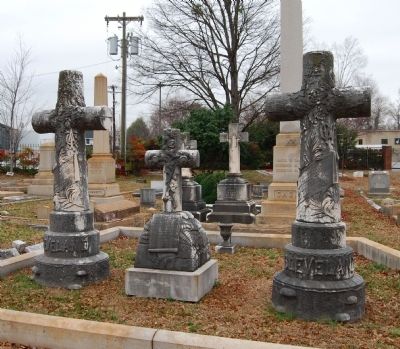
Photographed By Brian Scott, December 24, 2008
27. William Choice Cleveland Family Plot
From left to right:
Alelia Teresa Omberg
Wife of W.C. Cleveland
May 22, 1846-Feb 4, 1907
Harriett Emma
Daughter of W.C. & A.T. Cleveland
April 29, 1868-Dec 6, 1885
William Choice Cleveland
July 25, 1834-Jan 1, 1908
Cleveland was mayor of Greenville, a Confederate veteran, serving in the 16th S.C., Co. K (the "Buttermilk Rangers"), and member of the U.S. House of Representatives. Part of Cleveland's large estate helped to form the East Park Avenue neighborhood.
Wife of W.C. Cleveland
May 22, 1846-Feb 4, 1907
Harriett Emma
Daughter of W.C. & A.T. Cleveland
April 29, 1868-Dec 6, 1885
William Choice Cleveland
July 25, 1834-Jan 1, 1908
Cleveland was mayor of Greenville, a Confederate veteran, serving in the 16th S.C., Co. K (the "Buttermilk Rangers"), and member of the U.S. House of Representatives. Part of Cleveland's large estate helped to form the East Park Avenue neighborhood.
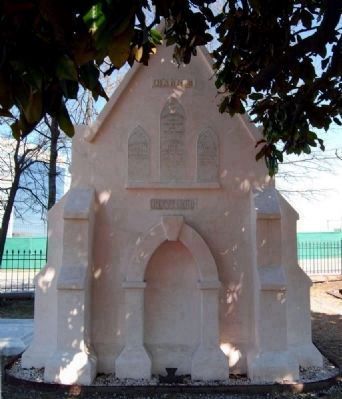
Photographed By Brian Scott, February 20, 2010
28. Cleveland/Harris Mausoleum
[Left Inscription]:
John W. Harris
Sept. 7, 1948
Nov. 16, 1908
[Center Inscription]:
Barnet F. Cleveland
Born
April 26, 1808
Died
Oct. 23, 1865
Mary H. Cleveland
Wife of
Barnet F. Cleveland
Sep. 26, 1829
March 10, 1909
[Right Inscription]:
Mary M. Cleveland
Wife of
John Harris
Mar. 30, 1848
Nov. 18, 1914
Sept. 7, 1948
Nov. 16, 1908
[Center Inscription]:
Born
April 26, 1808
Died
Oct. 23, 1865
Mary H. Cleveland
Wife of
Barnet F. Cleveland
Sep. 26, 1829
March 10, 1909
[Right Inscription]:
Wife of
John Harris
Mar. 30, 1848
Nov. 18, 1914
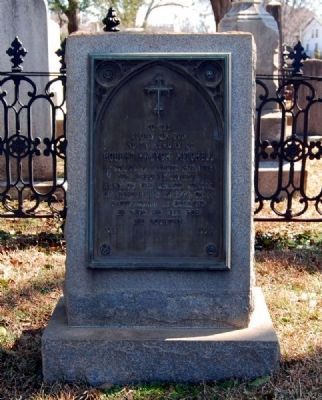
Photographed By Brian Scott, February 20, 2010
30. Robert Mazyck Mitchell Tombstone
(1916-1944)
(1916-1944)
Glory of God
and in Memory of
Robert Mazyck Mitchell
1st Lt. 508 Parachute Infantry
82d Airborne Division
Army of the United States.
On September 19, 1944, on a
battlefield in Holland
he gave his life for
his country.
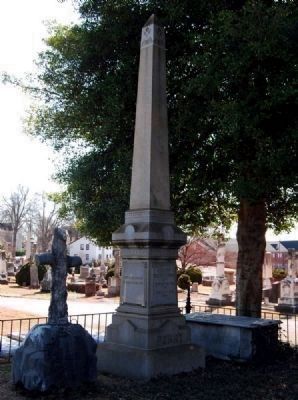
Photographed By Brian Scott, February 20, 2010
33. Governor Benjamin Perry (1805-1886) Tombstone (center)
[West Side]:
In Memory of
Benj. Franklin Perry
Born
November 20, 1805
Died
December 9, 1886
[East Side]:
District Judge
and
District Attorney
of the
Southern Confederacy
State Senator and
Provisional Governor
of South Carolina
and
United Stated Senator
Elect
Benj. Franklin Perry
Born
November 20, 1805
Died
December 9, 1886
[East Side]:
and
District Attorney
of the
Southern Confederacy
State Senator and
Provisional Governor
of South Carolina
and
United Stated Senator
Elect
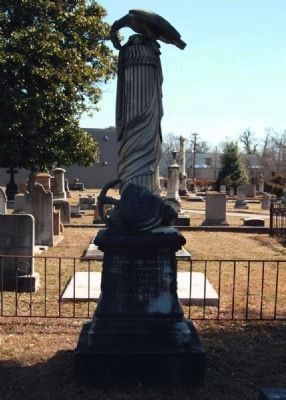
Photographed By Brian Scott, February 20, 2010
37. Benjamin Franklin Perry (1843-1860)
and Robert Hayne Perry (1854-1872)
Tombstone
and Robert Hayne Perry (1854-1872)
Tombstone
[West Side]:
Acting Midshipman
in the United States Navy
Born June 19th 1843
Died July 3rd 1860
Aged 17 Years
[East Side]:In Memory of
Robert Hayne Perry Born March 1, 1854
Died Nov. 18, 1872
Aged 18 Years
in the United States Navy
Born June 19th 1843
Died July 3rd 1860
Aged 17 Years
[East Side]:
Robert Hayne Perry Born March 1, 1854
Died Nov. 18, 1872
Aged 18 Years
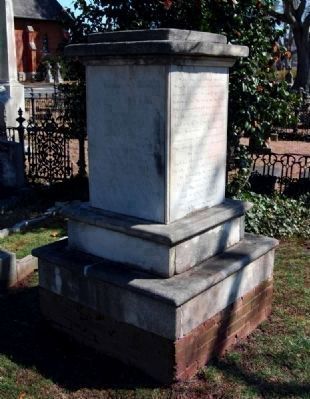
Photographed By Brian Scott, February 20, 2010
43. Ann Elizabeth Randolph Monument -
Erected by the Women of the Congregation
Erected by the Women of the Congregation
Rev. C.C. Pickney
Rector at Christ Church, Greenville
Daughter of
James L. McKenney
and
Ann F. Randolph
of Virginia.
Born in the City of Alexandria,
District of Columbia
20th July 1811
Died at Greenville
26th Jan. 1839.
[South Inscription]:
Endowed by nature with an excellent mind, which education carefully improved, and trained up from infancy in the fear of the Lord; she remembered her Creator in the days of her youth, and early began to develop the beauties of holiness, consecrating her powers unto God. She attained a large measure of his grace, and in the full symmetry of the Christian character, in humility of mind, in gentleness of temper, in elevation of soul and in purity of heart, she eminently adorned the Christian name.
[East Inscription]:
In all her relative duties, as a Mother and Daughter, she was singularly exemplary; and by her bright example as the wife of a Christian minister, daily endeavoring to recommend the Gospel which he preached. By the loss his only child, her father's house is left desolate and a bereaved husband, her infant children, and numerous relatives and friends mourn her early death.
Credits. This page was last revised on November 17, 2020. It was originally submitted on April 18, 2008, by Brian Scott of Anderson, South Carolina. This page has been viewed 3,578 times since then and 79 times this year. Last updated on June 23, 2008, by Brian Scott of Anderson, South Carolina. Photos: 1. submitted on April 18, 2008, by Brian Scott of Anderson, South Carolina. 2. submitted on February 20, 2010, by Brian Scott of Anderson, South Carolina. 3. submitted on June 23, 2008, by Brian Scott of Anderson, South Carolina. 4. submitted on September 20, 2009, by Brian Scott of Anderson, South Carolina. 5. submitted on February 20, 2010, by Brian Scott of Anderson, South Carolina. 6. submitted on April 18, 2008, by Brian Scott of Anderson, South Carolina. 7. submitted on June 23, 2008, by Brian Scott of Anderson, South Carolina. 8. submitted on February 20, 2010, by Brian Scott of Anderson, South Carolina. 9. submitted on January 11, 2009, by Brian Scott of Anderson, South Carolina. 10, 11. submitted on February 20, 2010, by Brian Scott of Anderson, South Carolina. 12. submitted on September 20, 2009, by Brian Scott of Anderson, South Carolina. 13. submitted on February 20, 2010, by Brian Scott of Anderson, South Carolina. 14. submitted on July 23, 2009, by Brian Scott of Anderson, South Carolina. 15. submitted on July 24, 2009, by Brian Scott of Anderson, South Carolina. 16. submitted on February 20, 2010, by Brian Scott of Anderson, South Carolina. 17. submitted on April 11, 2009, by Brian Scott of Anderson, South Carolina. 18. submitted on June 23, 2008, by Brian Scott of Anderson, South Carolina. 19, 20, 21. submitted on February 20, 2010, by Brian Scott of Anderson, South Carolina. 22. submitted on June 23, 2008, by Brian Scott of Anderson, South Carolina. 23, 24. submitted on February 20, 2010, by Brian Scott of Anderson, South Carolina. 25. submitted on April 11, 2009, by Brian Scott of Anderson, South Carolina. 26. submitted on February 20, 2010, by Brian Scott of Anderson, South Carolina. 27. submitted on January 11, 2009, by Brian Scott of Anderson, South Carolina. 28, 29, 30. submitted on February 20, 2010, by Brian Scott of Anderson, South Carolina. 31. submitted on January 11, 2009, by Brian Scott of Anderson, South Carolina. 32. submitted on March 15, 2010, by Brian Scott of Anderson, South Carolina. 33, 34, 35, 36, 37, 38, 39, 40, 41, 42. submitted on March 19, 2010, by Brian Scott of Anderson, South Carolina. 43. submitted on February 20, 2010, by Brian Scott of Anderson, South Carolina. 44. submitted on January 11, 2009, by Brian Scott of Anderson, South Carolina. 45, 46, 47. submitted on April 11, 2009, by Brian Scott of Anderson, South Carolina. • Kevin W. was the editor who published this page.
